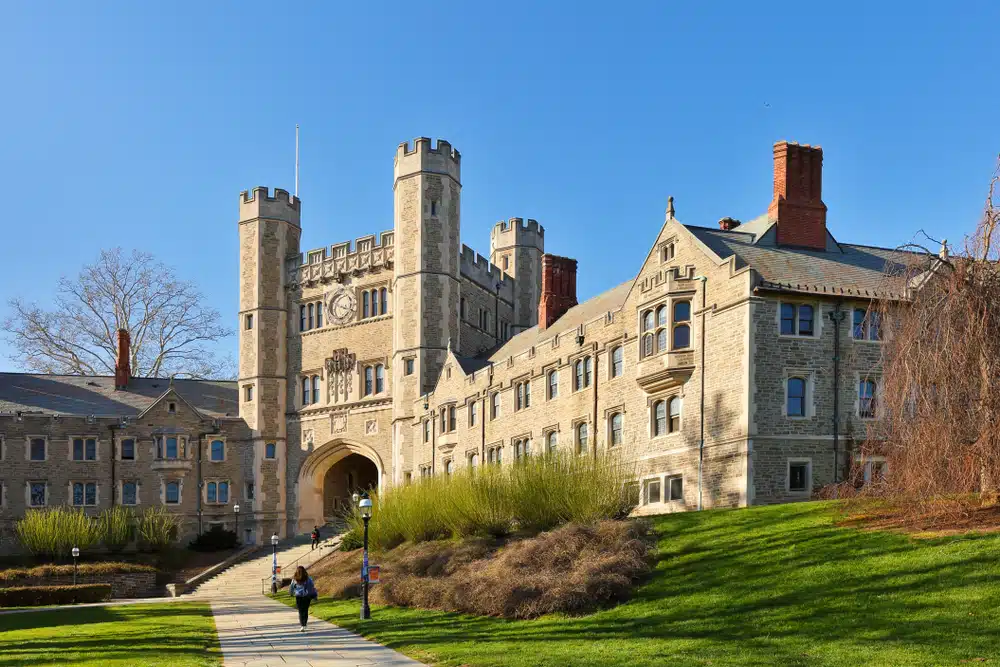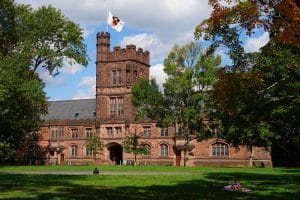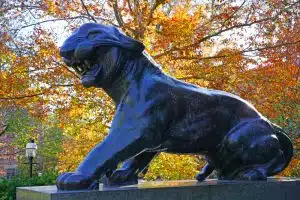Fun Facts About Princeton University
Princeton University, one of the most prestigious institutions of higher learning worldwide, is steeped in rich history and tradition. There is more to this Ivy League university than what meets the eye. Here are fun facts about Princeton that are sure to enlighten and surprise you.
A Brief History of Princeton University
Princeton University, originally known as the College of New Jersey, was founded in 1746. It was the fourth college to be established in the American colonies. The college was founded by the New Light Presbyterians, who sought to establish an institution that would educate ministers and promote religious freedom.
Initially located in Newark, the college moved to Princeton in 1756, which became its permanent home. The move was prompted by the generous donation of land and funds by the New Jersey legislature, as well as the desire to establish a more rural and serene environment for the students.
The name ‘Princeton‘ was adopted in 1896, long after the village named Princeton had been established around it. The name change was a reflection of the college’s growing reputation and its close association with the town.
The school’s relocation to Princeton included the construction of Nassau Hall, the oldest building on campus, which holds a special place in the nation’s history. It served as the temporary home for the Continental Congress in 1783, making Princeton the nation’s capital for a short time. The building’s iconic architecture and historical significance make it a beloved symbol of the university.
Significant Historical Events
Princeton played a key role in America’s early history. The Battle of Princeton, a pivotal battle in the Revolutionary War, was fought on its campus grounds, adding a rich layer to its historical heritage. The battle took place on January 3, 1777, when General George Washington and his troops launched a surprise attack on British forces stationed in Princeton. The American victory at Princeton boosted morale and helped turn the tide of the war in favor of the Patriots.
Furthermore, the Princeton Convention of 1783, a crucial moment in the Revolutionary War, took place right here. The convention was a gathering of delegates from several states to discuss issues related to the war and the future of the newly independent nation. It was during this convention that General George Washington delivered his famous Farewell Address to the Army, in which he emphasized the importance of unity and the preservation of the principles fought for during the war.
In the modern era, the university is recognized for innovations such as launching one of the country’s first ‘no-loan’ financial aid programs. This initiative, launched in 2001, replaced student loans with grants, making education more affordable. The program has since been expanded and serves as a model for other universities seeking to increase accessibility and reduce the burden of student debt.
Princeton University continues to be a leading institution of higher education, known for its rigorous academic programs, distinguished faculty, and vibrant campus community. Its rich history and commitment to excellence make it a cherished institution in the United States.
Unique Traditions at Princeton
Princeton University is not only renowned for its academic excellence but also for its vibrant and rich traditions that have been passed down through generations of students. These traditions add a unique flavor to the campus culture and create a sense of community and belonging among the Princeton community.
Annual Events and Festivals
Princeton is known for its lively annual events and festivals that bring together students, alumni, and the local community. One of the most anticipated events is the Reunions, held annually during the last weekend of May. This event is considered to be the largest and most spirited alumni gathering in the world. Alumni from various graduating classes come back to campus to reconnect with old friends, reminisce about their college days, and celebrate their Princeton pride. The Reunions are filled with joyous reunions, class dinners, live music performances, and a festive atmosphere that truly captures the essence of the Princeton spirit.
Another marquee event that showcases the Princeton spirit is the ‘P-rade’. This massive parade takes place during the Reunions and features thousands of alumni and students strolling through campus dressed in their orange and black Princeton gear. The P-rade is a spectacle of school pride and unity, as participants march together, showcasing their love for Princeton and their shared memories of their time on campus.
In addition to the Reunions and the P-rade, Princeton also hosts the Cane Spree, another unique tradition that brings together freshman and sophomore students. The Cane Spree is an annual athletic competition where participants contend in various sporting events, including a race where freshmen attempt to protect their canes from sophomores. This friendly rivalry fosters camaraderie among the students and adds an element of excitement to campus life.
Unique Student Traditions
Student life at Princeton is marked by unique and time-honored traditions that have become an integral part of the university’s culture. One of the most significant of these traditions is the Honor Code, a student-run system that has been in place since 1893. The Honor Code emphasizes academic integrity and trust among students. Under this code, students are expected to uphold the highest standards of honesty and integrity in all academic endeavors, creating an environment of mutual respect and trust.
Another beloved tradition at Princeton is the Arch Sing. Every Friday night, acappella groups gather under Princeton’s archways to perform a variety of songs, creating a vibrant musical ambiance on campus. The Arch Sing is a cherished tradition that showcases the musical talents of Princeton students and brings the community together through the power of music.
Princeton’s history is also filled with quirky yet fascinating traditions that have left a lasting impression on the university’s folklore. One such tradition is the ‘Nude Olympics’, a midnight, clothes-free run that used to take place during the first snow of winter. Although this tradition has been discontinued by the university due to safety concerns, it still holds a place in Princeton’s history and serves as a reminder of the unique and sometimes unconventional spirit of the Princeton community.
These traditions, both grand and small, contribute to the vibrant tapestry of life at Princeton University. They create a sense of belonging, foster a strong community spirit, and leave a lasting impression on the hearts and minds of all who have the privilege of being a part of the Princeton experience.
Notable Alumni and Their Contributions
Famous Figures in Politics
Princeton has produced numerous distinguished graduates making significant impacts in politics. James Madison and Woodrow Wilson, both graduated from Princeton, ascended to the President’s office. Madison, known as the “Father of the Constitution,” played a pivotal role in the drafting and ratification of the United States Constitution. Wilson, on the other hand, was a visionary leader who championed the League of Nations and played a key role in shaping the post-World War I world order.
More recently, Supreme Court Justice Sonia Sotomayor, a Princeton alumna, has become a prominent figure in American jurisprudence. Her groundbreaking career has been marked by her commitment to upholding the principles of justice and equality. Former First Lady Michelle Obama, another celebrated Princeton alumna, has dedicated her life to advocating for education, health, and the empowerment of young people.
In the international sphere as well, Princetonians have made their mark. U.N. Secretary-General Kofi Annan, a graduate of Princeton, was a tireless advocate for peace, human rights, and development. His leadership during his tenure at the United Nations earned him widespread admiration and respect. Queen Noor of Jordan, also an alumna of Princeton, has been a prominent voice for women’s rights, education, and cross-cultural understanding.
Leaders in Science and Technology
Princeton University has a strong legacy in the field of science and technology. The university is proud of its Nobel laureates like Richard Feynman, known for his work in quantum mechanics, and John Nash, the famed mathematician whose life was depicted in the movie “A Beautiful Mind.” Feynman’s contributions to theoretical physics revolutionized our understanding of the subatomic world, while Nash’s groundbreaking work in game theory earned him international acclaim.
In the realm of technology, Jeff Bezos, the founder of Amazon and one of the wealthiest people on the planet, is a Princeton graduate. Bezos’ entrepreneurial spirit and innovative mindset have reshaped the way we shop and consume goods. Eric Schmidt, former CEO of Google, is another notable Princetonian who played a pivotal role in the development of the internet giant. His leadership and strategic vision propelled Google to become one of the most influential companies in the world.
Alan Turing, often referred to as the father of modern computing, is also counted among Princeton’s notable alumni. Turing’s groundbreaking work in the field of computer science laid the foundation for the digital age we live in today. His contributions during World War II, particularly in breaking the German Enigma code, played a crucial role in the Allied victory.
Princeton’s Campus Architecture
Historic Buildings and Their Stories
A stroll through Princeton’s campus is akin to a journey through American architectural history. One of the most notable structures on campus is Nassau Hall, a National Historic Landmark. It was the largest building in the colonies when completed in 1756 and witnessed significant Revolutionary War events.
Nassau Hall stands as a testament to Princeton’s rich history, having served as both a college and a temporary capitol of the United States. During the Battle of Princeton in 1777, the building was occupied by British troops and later by American forces. It was in the hallowed halls of Nassau Hall that the Continental Congress met, and the Articles of Confederation were ratified.
Another architectural gem on campus is the Cleveland Tower, a beautiful example of collegiate gothic architecture. The tower, part of the Graduate College, is known for its carillon – one of the largest musical instruments in the world, featuring 67 bells.
As the bells chime from the Cleveland Tower, their melodic tones fill the air, adding a touch of enchantment to the campus atmosphere. The carillon is played by skilled musicians who create breathtaking melodies that resonate throughout Princeton’s campus, creating a sense of harmony and tranquility.
Modern Structures and Their Significance
In addition to historic buildings, Princeton University is not shy about embracing modern architecture. The Lewis Science Library, designed by the renowned architect Frank Gehry, is a spectacular example of contemporary design. The library’s unique exterior, with its undulating stainless steel panels, captures the imagination and stands as a symbol of innovation.
Inside the Lewis Science Library, students and researchers are surrounded by an environment that fosters creativity and intellectual exploration. The open spaces and state-of-the-art facilities provide a conducive setting for scientific discovery and collaboration.
Speaking of modern structures, the campus also houses the Andlinger Center for Energy and the Environment, a hub for cutting-edge research in sustainable energy. The center’s sleek and sustainable design reflects its mission to address the pressing challenges of climate change and energy sustainability.
Within the walls of the Andlinger Center, scientists and engineers work tirelessly to develop innovative solutions that will shape the future of renewable energy. From advanced solar technologies to breakthroughs in energy storage, the center is at the forefront of pioneering research that will have a lasting impact on our planet.
The Princeton University Chapel, although built in the 1920s, holds a modernist appeal with its comprehensive portrayal of Christian symbolism. It’s the third-largest university chapel in the world, showcasing amazing stained-glass windows and intricate woodwork.
Stepping into the Princeton University Chapel is like entering a sanctuary of serenity and spiritual reflection. The sunlight streaming through the vibrant stained-glass windows casts a kaleidoscope of colors on the pews below, creating a mesmerizing display of artistry and faith.
Throughout the chapel, intricate woodwork adorns the walls and ceilings, showcasing the craftsmanship of skilled artisans. The delicate carvings and ornate details tell stories of devotion and dedication, inviting visitors to contemplate the beauty of both the divine and the human spirit.
Academic Achievements and Innovations
Breakthrough Research at Princeton
Princeton’s research portfolio is varied and vast, with breakthroughs achieved in multiple disciplines. In 1961, Princeton made history as its Plasma Physics Laboratory made the first successful demonstration of controlled nuclear fusion. More recently, Princeton scholars have made significant contributions to the discovery of gravitational waves and the development of digital technology.
Princeton’s Global Health Program is also doing laudable work, addressing worldwide health crises like malaria, AIDS, and the current COVID-19 pandemic. The program’s focus is not just on finding solutions for epidemics and diseases but also on understanding the social, political, and economic factors influencing health outcomes.
Award-Winning Faculty and Students
The university is home to world-renowned faculty members, including Nobel laureates, Pulitzer Prize winners, and MacArthur fellows. Among the luminaries, Angus Deaton, a laureate in Economic Sciences, and Toni Morrison, a laureate in Literature, stand out for their monumental contributions to their respective fields.
Not to be left behind, Princeton’s students regularly receive top honors. Whether it’s a Rhodes Scholarship, a Marshall Scholarship, or the prestigious Gates Cambridge Scholarship, Princeton students continue to reach academic heights and contribute positively to society.
Princeton University is a fascinating amalgam of historical depth, rich tradition, academic prowess, architectural grandeur, and lasting impact on world leaders. It’s no surprise that it is one of the most esteemed institutions in the world today.
How AdmissionSight Can Help You with College Admissions
AdmissionSight is a college consulting firm that provides personalized assistance to students throughout the college admissions process. Here are some ways that AdmissionSight can help you:
Admissions strategy: AdmissionSight can help you develop a strategic plan for your college application process. Our professional consultants can assist with identifying schools that are a good fit for your academic, extracurricular, and personal goals and help you plan and prioritize your application strategy.
Application review: AdmissionSight can review your application and provide feedback on how to improve it. We can offer suggestions on making your application stand out and highlighting your strengths and unique qualities.
Essay coaching: AdmissionSight can help you craft compelling essays that showcase your personality, goals, and achievements. We can guide you through the essay writing process and provide feedback on your drafts to help you refine your writing.
Interview preparation: AdmissionSight can provide interview coaching to help you feel confident and prepared for college interviews. Our experts can offer tips on how to present yourself professionally and how to answer common interview questions.
Extracurricular planning: AdmissionSight can help you plan and develop your extracurricular activities to make them more impactful and meaningful. We can suggest activities that align with your interests and goals and provide guidance on demonstrating your leadership and initiative.
Overall, AdmissionSight can provide valuable guidance and support throughout the college admissions process to help you maximize your chances of getting accepted into the college of your choice.
With a high success rate of over 75%, we have built a strong network in the past decade. Book an initial consultation today, free of charge!








































